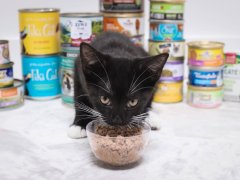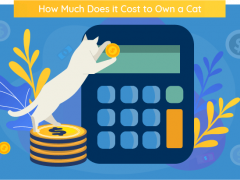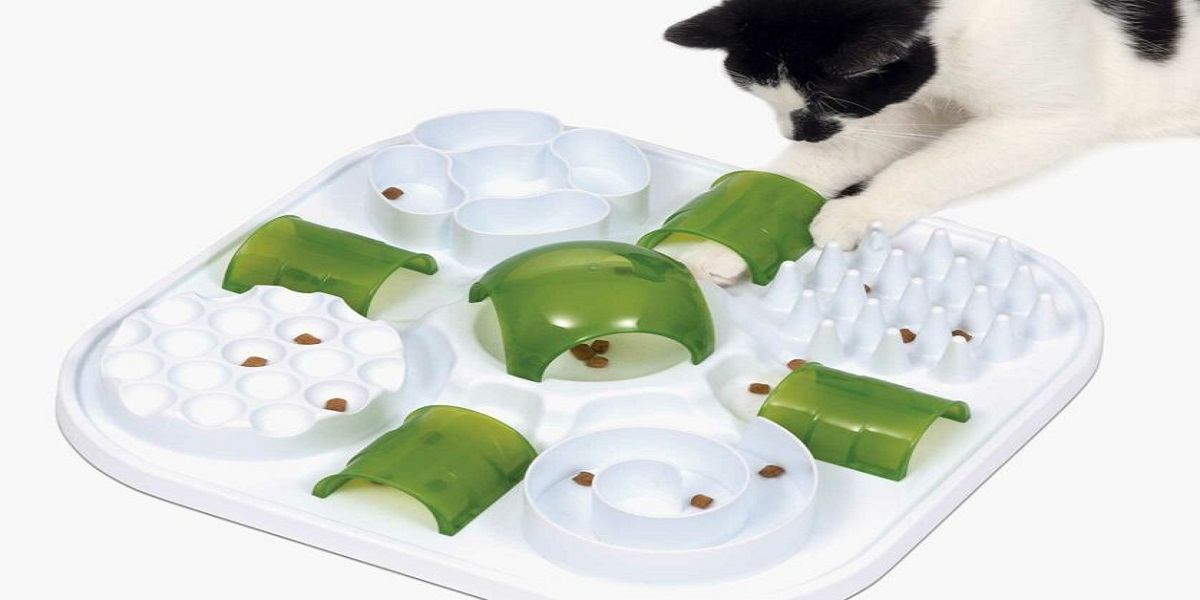
Think about how you feed your cat. More than likely, you provide kibble or wet food into a bowl once or twice a day, in the same place every day. Yet, cats are natural predators whose behavioral needs are very similar to their wild counterparts.
The natural feeding pattern for wild cats is to eat multiple small meals throughout the day, with several hunting attempts daily. Of these hunting efforts, only around half actually lead to a prey item being captured.
This is far removed from how we feed our domestic cats. With an increase in feline obesity and behavioral problems (especially in cats kept indoors), the use of alternative methods of feeding your cat can be hugely beneficial. This article will consider using puzzle feeders as an alternative means of feeding.
Also Read: The 10 Best Cat Slow Feeders & Puzzle Feeders
What Are Puzzle Feeders?
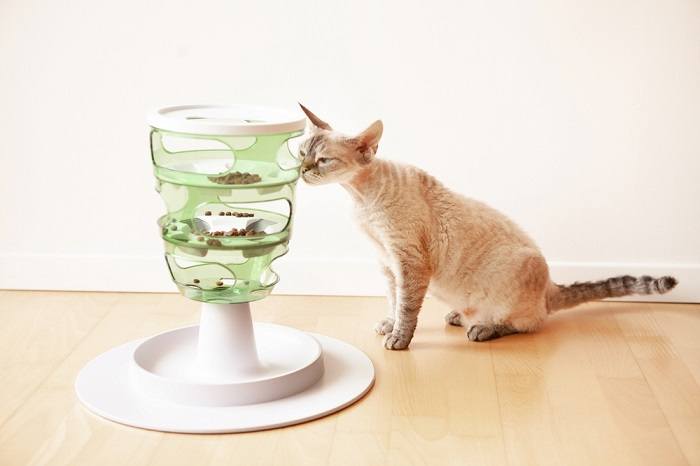
A puzzle feeder is an object that holds food or treats that your cat must manipulate to access the food items. They can be mobile (requiring them to be rolled or pushed) or stationary.
Mobile feeders tend to be balls, tubes, or eggs, and usually have holes to release food. Stationary puzzles will typically have a sturdy base with holes, cups, or channels that cats then have to use their tongue or paws to retrieve the food.
Also Read: Cat Obesity Chart: Find Out if Your Cat is Obese
Do Cats Like Puzzle Feeders?
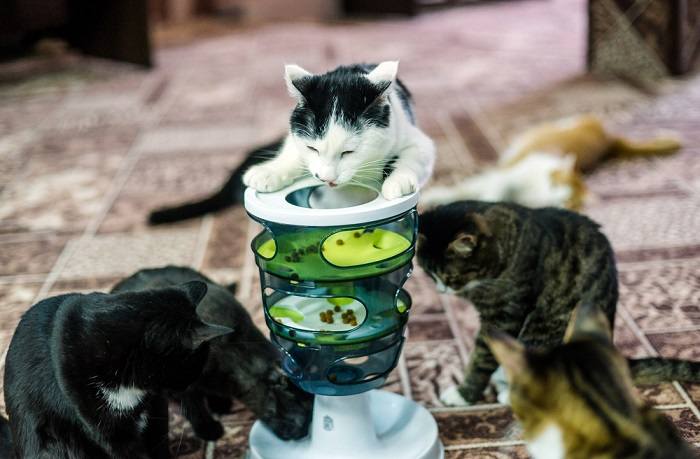
It can take a little bit of time to teach your cat to use a puzzle feeder, but studies have shown that cats who use puzzle feeders are happier and more physically fit.
They also show fewer behavioral problems such as aggression and over-grooming. These metrics allow us to state that puzzle feeders, which enable our cats to tap into their natural hunting instincts, hugely benefit our feline friends.
5 Reasons Puzzle Feeders Are Good For Cats
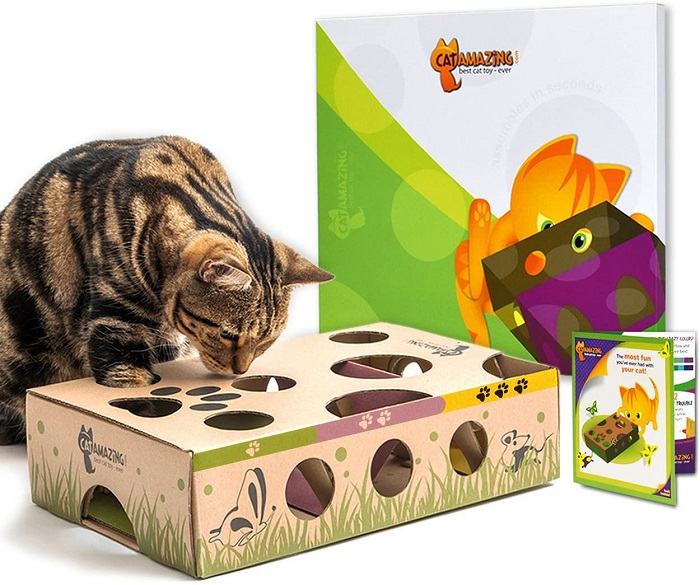
Puzzle feeders come in many different styles that tap into your cat’s hunting instincts.
1. Encourage Mental Stimulation And Reduce Boredom
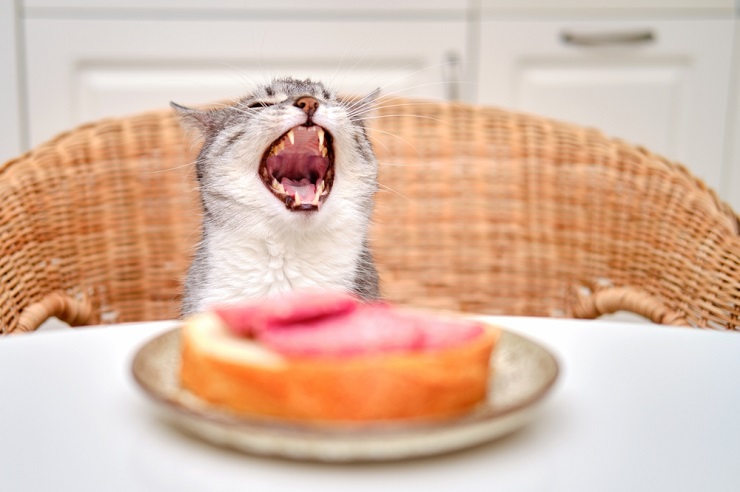
Increasingly, especially in urban environments, our cats are being kept indoors. Living solely indoors can sometimes lead to boredom and a lack of appropriate mental stimulation that a cat would naturally experience being outside. Puzzle feeders force your cat to work and use their brains to access food. This helps beat the boredom and can be very positive and rewarding for your furry friend!
2. Encourage Physical Activity
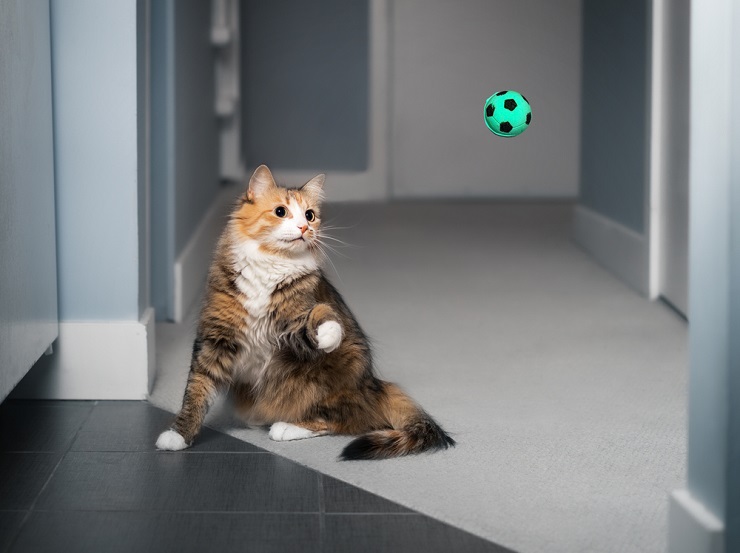
Obesity is a growing epidemic in our feline friends. Obesity increases the risk of many significant medical disorders such as joint problems, cancers, feline diabetes, and high blood pressure. Puzzle feeders encourage your cat to work for her food and eat more slowly. They have been shown to reduce the prevalence of obesity in the feline population.
3. Slow Down The Eating Rate
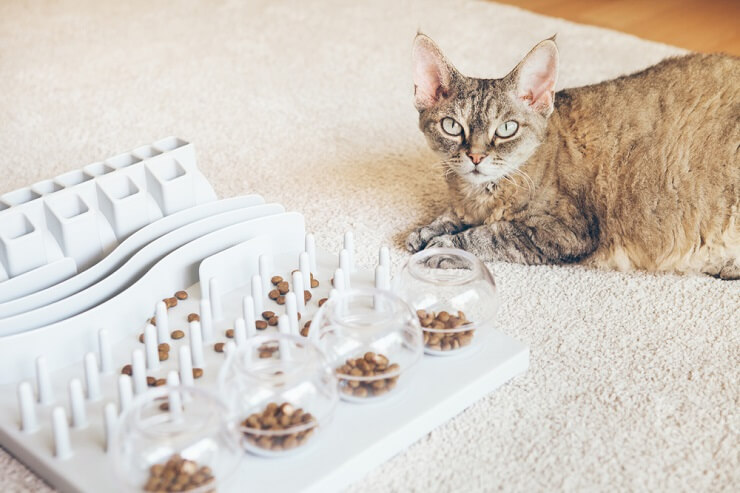
I’m sure it comes as no surprise to some cat owners out there that the greedy, speedy, over-eater exists in the feline world, too! Often this lends itself to an unpleasant regurgitation of cat food somewhere around the house. Puzzle feeders force these greedy kitties to slow up the pace and work for their food.
4. Allow Natural Hunting Behaviors
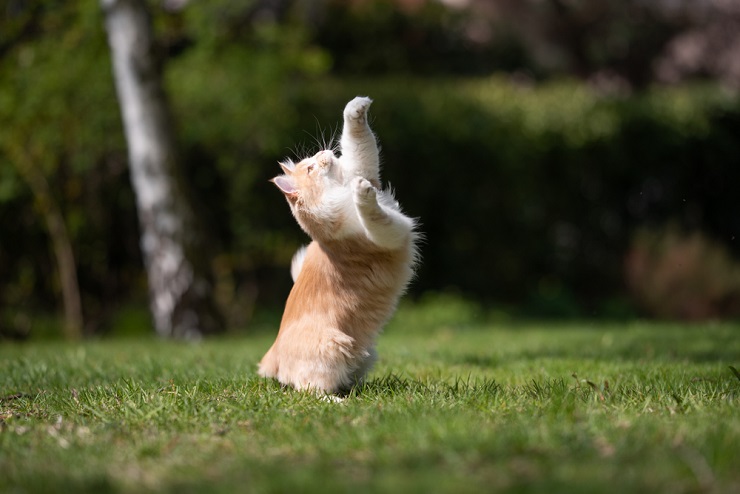
It’s no secret that cats love to hunt; it’s hard-wired in their DNA. The traditional way of feeding our cats does not allow them to behave naturally, leading to the development of frustration behaviors. Puzzle feeders allow this natural hunting behavior to be acted on by your cat, leading to positive mental and physical enrichment.
Also Read: Is Your Cat Depressed? Signs, Symptoms & How to Help
5. Reduce Stress And Associated Medical Conditions
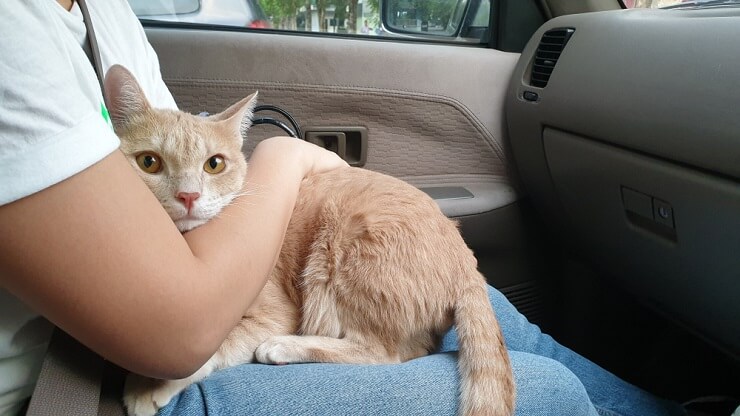
Studies have shown puzzle feeders reduce stress and anxiety in cats. They have also been used as part of multifaceted management of conditions associated with stress in cats, such as over-grooming, feline idiopathic cystitis, inappropriate urination, obesity, inappropriate aggression behaviors, and fear behaviors.
If you suspect your cat suffers from one of these disorders, always speak to your local veterinarian to ensure your pet receives the optimum, tailored treatment to manage their condition. Behavioral conditions in cats can result from underlying medical disorders, and your cat must get a clean bill of medical health before assuming a behavioral problem.
What Type Of Puzzle Feeders Are Best For Cats?

When choosing a puzzle feeder, think about your cat’s play style and food preferences.
The type of puzzle feeder that is best for your cat (and you!) will be dependent on a few different factors, and these should be taken into consideration to improve compliance and enjoyment from your new puzzle feeder:
Food Preference

Any cat parent knows that feline people can be very particular when it comes to what they eat. Some cats will only want dry and others will only entertain wet food. These preferences should be taken into account when choosing your puzzle feeder. Wet food is better suited to stationary puzzle feeders, whereas dry food can be used with stationary or mobile puzzles.
Physical Capabilities

If you have a cat with special needs or disabilities, you may worry that a puzzle feeder might make it too hard for your kitty. However, a recent literature review has found that all cats can use puzzle feeders, including kittens, elderly cats, blind cats, three-legged cats, or any other cat with disabilities. You might need to experiment with the type of puzzle to find a good fit for your furry friend.
The Way Your Cat Interacts With Toys
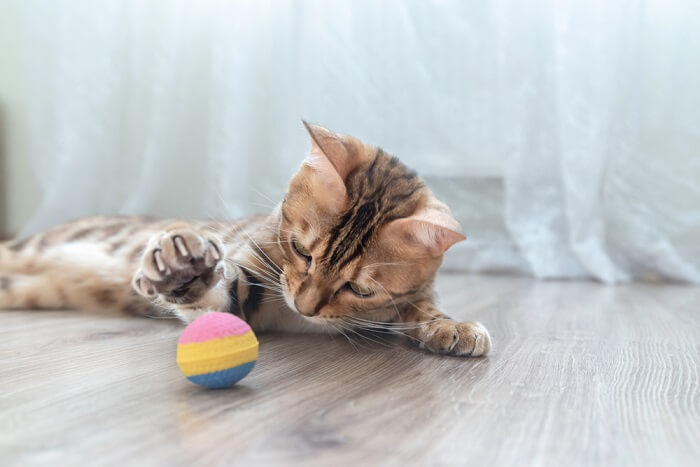
By observing how your cat plays with their toys, you can get an idea of the best puzzle feeder to start with. If your cat primarily plays with toys with their paws, then either a stationary or mobile feeder will work well. If they primarily play with their nose, it may be best to start with a mobile feeder.
Also Read: The 12 Best Cat Toys: Keep Your Cat Fit And Happy With These Irresistible Toys
Are You OK With Food Around The House?
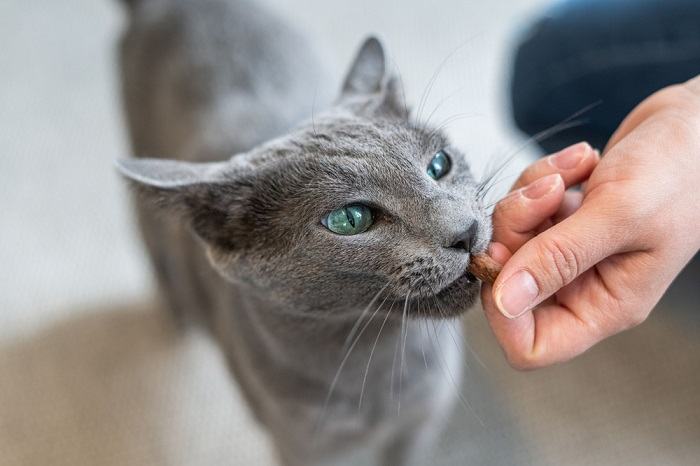
Mobile puzzle feeders may result in bits of kibble lying around the house. Given this isn’t everyone’s cup of tea, make sure to consider this when choosing the right puzzle feeder for your home. Equally important, if you have other pets with strict dietary requirements, will stray bits of kibble cause problems for them?
Do You Have Financial Constraints?

If pennies are tight, there are many DIY options for puzzle feeders that can be made with bits and pieces around the house and a bit of imagination (see below for suggestions).
Do You Have Time Constraints?
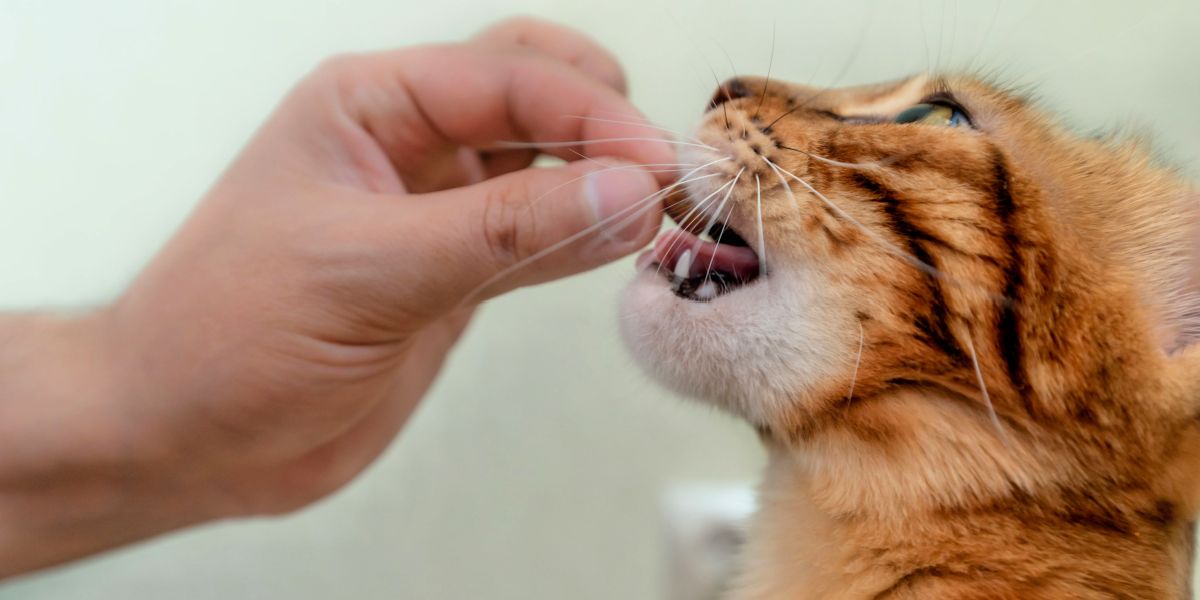
If you lead a hectic lifestyle, spending hours making a Pinterest-worthy puzzle feeder is likely an impractical undertaking. Instead, consider buying a ready-made option. There are many fantastic products on the market—make sure to work through the above factors to ensure your puzzle feeder is suited to your furry companion.
How To Introduce Puzzle Feeders
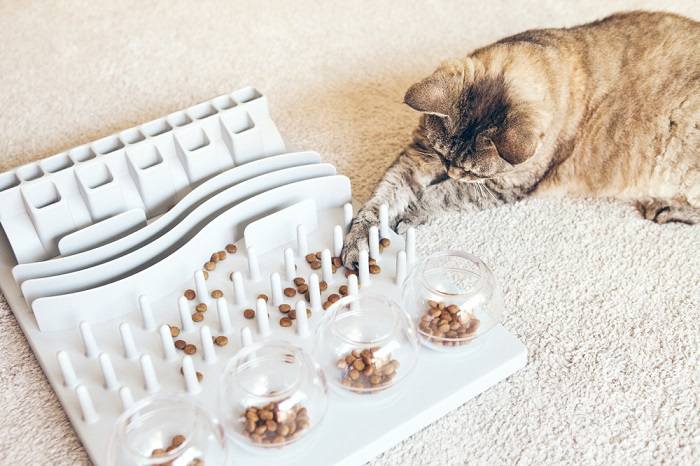
So, you’ve decided to get your cat a puzzle feeder, but you’re not sure how to get your cat on board with the concept? The best way is to do this gradually.
You may need to try different puzzles to find one your cat likes. Start by continuing to offer food in their bowl whilst they learn how to use it. Adjust the puzzle, if possible, to make it easy to use initially.
It is important to ensure a fun and positive experience for your cat from the beginning. Once your cat can use the puzzle successfully without signs of stress or anxiety, gradually shift to using this as the primary or sole way to provide food for your cat. This review paper and associated website have some fantastic info to get you started!
How To Make Your Own Puzzle Feeder
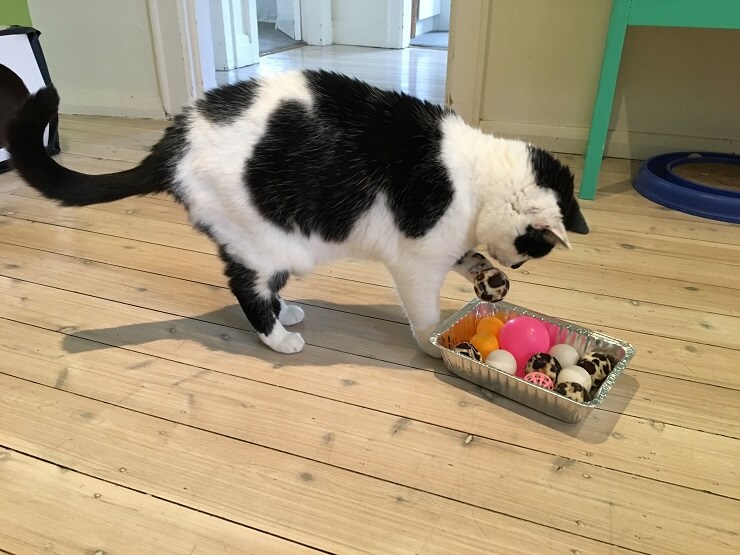
Pushka’s home made puzzle feeder constructed by our very own cat behaviorist’s Melina Grin
There are plenty of fantastic puzzle feeders on the pet market these days. As we’ve discussed, the type you choose will be dependent on your cat’s personal preferences and physical capabilities, but if you are on a tight budget, don’t let this put you off!
Puzzle feeders don’t have to be elaborate or expensive. A DIY puzzle feeder can have just as much benefit for your furry feline as the most expensive one on the market. Youtube and Pinterest are great starting points for how-to guides to spark your imagination with many very imaginative ideas out there; however, things don’t have to be complex.
For example, an empty (clean) plastic soda bottle with small kibble-sized holes cut in the sides with an X-ACTO knife can make a great puzzle feeder. Once you have carefully cut the holes, simply put your cat’s kibble into the bottle. They then have to roll it over the floor to release their meal!
Final Thoughts

Cats are programmed to want to work for their food, and even the laziest cat can be brought on board with this concept. The benefits of using puzzle feeders to enrich your cat’s environment for their mental and physical health are widely proven.
If you are keen to try puzzle feeding but uncertain how to get started, remember that your local veterinary clinic will be happy to provide you with some helpful hints and tips!
Frequently Asked Questions
Are interactive feeders good for cats?
Yes, interactive or puzzle feeders have been shown to help with many behavioral and stress-associated issues in domestic cats.
What are puzzle feeders?
A puzzle feeder is an object that holds food or treats that your cat must manipulate in order to access the food items.
How do you make interactive cat toys?
There are a whole host of different ways to make DIY puzzle feeders for cats. A simple example is a clean bottle with small holes cut to allow kibble to fall out. For more ideas, check out Food Puzzles for Cats.
-
Dantas. L et al. (2016) Food puzzle for cats: Feeding for physical and emotional wellbeing. Journal of Feline Medicine and Surgery. 18, 723-732 DOI https://doi.org/10.1177/1098612X16643753 Retrieved 15th June 2022
-
Delgado and Johnson (2022) Food Puzzles for Cats. Available at http://foodpuzzlesforcats.com/ Retrieved 16th June 2022
-
Delgado and Dantas (2020) Feeding cats for optimal mental and behavioural well-being. Veterinary Clinics: North America. 50 939-953. DOI https://doi.org/10.1016/j.cvsm.2020.05.003 Retrieved 16th June 2022
-
iCatCare (2019) Puzzle Feeders. Available at https://icatcare.org/advice/puzzle-feeders/ Retrieved 16th June 2022
-
Purina (2022) How to make a puzzle cat feeder. Available at https://www.purina.com/articles/cat/feeding/diy-cat-puzzle-feeder Retrieved 16th June 2022





